Olympus M.Zuiko Digital 14-42mm f/3.5-5.6 MkII Lens
Olympus M.Zuiko Digital 14-42mm f/3.5-5.6 MkII: Performance
At 14mm and f/3.5, the sharpness in the centre of the frame is already outstanding, and the sharpness towards the edges is fairly good. Stopping down the aperture improves sharpness towards the edges, exceeding good levels by f/4. Peak quality across the frame is achieved between f/4 and f/5.6 for this focal length.Zooming further into the range, sharpness levels follow a similar pattern to 14mm, with centre sharpness being very high from maximum aperture and the clarity towards the edges catching up as the lens is stopped down. The best compromise for sharpness across the frame is achieved between f/5.6 and f/8, where the clarity in the centre is excellent and good towards the edges.
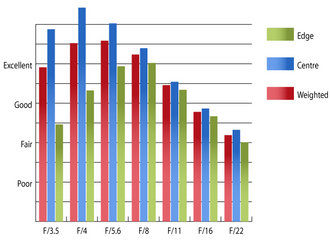 MTF at 14mm | 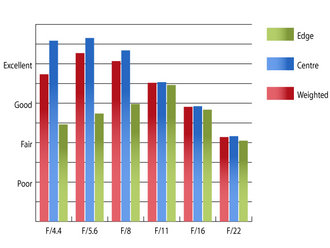 MTF at 25mm | |
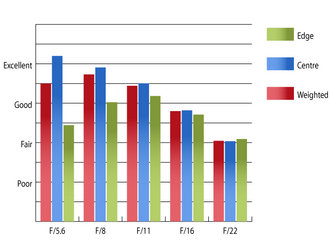 MTF at 42mm | How to read our chartsThe blue column represents readings from the centre of the picture frame at the various apertures and the green is from the edges. Averaging them out gives the red weighted column.The scale on the left side is an indication of actual image resolution. The taller the column, the better the lens performance. Simple. For this review, the lens was tested on an Olympus PEN E-PL1 using Imatest. |
Levels of chromatic aberrations are kept incredibly low throughout the zoom range. At their worst, they just exceed half a pixel width towards the edges at f/3.5, which should no pose any issues, even in large prints or harsh crops from near the edges of the frame.
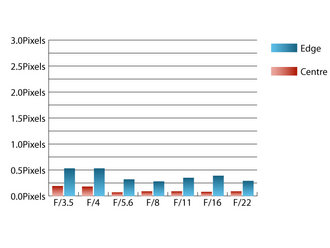 CA at 14mm | 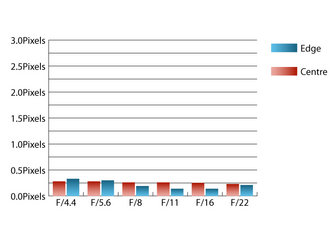 CA at 25mm | |
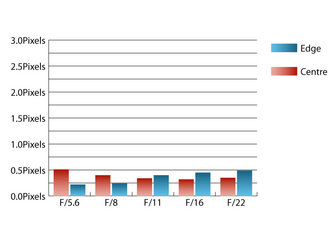 CA at 42mm | How to read our chartsChromatic aberration is the lens' inability to focus on the sensor or film all colours of visible light at the same point. Severe chromatic aberration gives a noticeable fringing or a halo effect around sharp edges within the picture. It can be cured in software.Apochromatic lenses have special lens elements (aspheric, extra-low dispersion etc) to minimize the problem, hence they usually cost more. For this review, the lens was tested on an Olympus PEN E-PL1 using Imatest. |
Falloff of illumination towards the corners of the frame may be noticeable when photographing plain subjects at 14mm and f/3.5, as here the corners are 1.3 stops darker than the image centre. Stopping the aperture down to f/5.6 results in visually even illumination at this focal length. Falloff is reduced at 42mm, as the corners are only 0.4stops darker than the image centre at this focal length, and visually even illumination is achieved by f/8.
Olympus Micro Four Thirds compatible cameras automatically correct distortion in camera, so the following won't be noticeable if shooting JPEG images, or if the software supplied with the camera is used to convert the RAW images. It is lucky that this automatic correction is in place, as 7.7% barrel distortion was detected by Imatest at 14mm, which is very strong indeed. Barrel distortion is still present at 42mm but at a diminished level of 0.4%. The distortion pattern is uniform across the frame, so this should be fairly straightforward to correct in image editing software afterwards.
Even when shooting directly in to the light, this lens seems very resistant to flare and loss of contrast. At 14mm, a little flare my appear when strong light sources outside of the frame catch the front element and a little contrast may be lost at 42mm when shooting directly into harsh light. No lens hood is supplied, but one will very rarely be needed.
Add your message
Login required
Please login here or if you've not registered, you can register here. Registering is safe, quick and free.
Please login here or if you've not registered, you can register here. Registering is safe, quick and free.
photodo Stats
1102 lenses
428 MTF tests
74 in-depth photodo reviews
100+ users join each day
Help the lens community by reviewing or rating a lens today via our lens search
428 MTF tests
74 in-depth photodo reviews
100+ users join each day
Help the lens community by reviewing or rating a lens today via our lens search
Latest Lens Reviews
- Chinon 28mm f/2.8 Vintage Lens Review
- Canon EF 70-200mm f/4L IS II USM Lens Review
- Samyang AF 85mm f/1.4 EF Review
- Sigma 70mm f/2.8 DG Macro Art Review
- Samyang AF 24mm f/2.8 FE Review
- Meike 50mm f/1.7 Review
- Tamron 70-210mm f/4 Di VC USD Review
- Lensbaby Burnside 35mm f/2.8 Review
- Asahi Super Takumar 50mm f/1.4 Review
- Asahi Super-Multi-Coated Takumar 135mm f/3.5 Review








